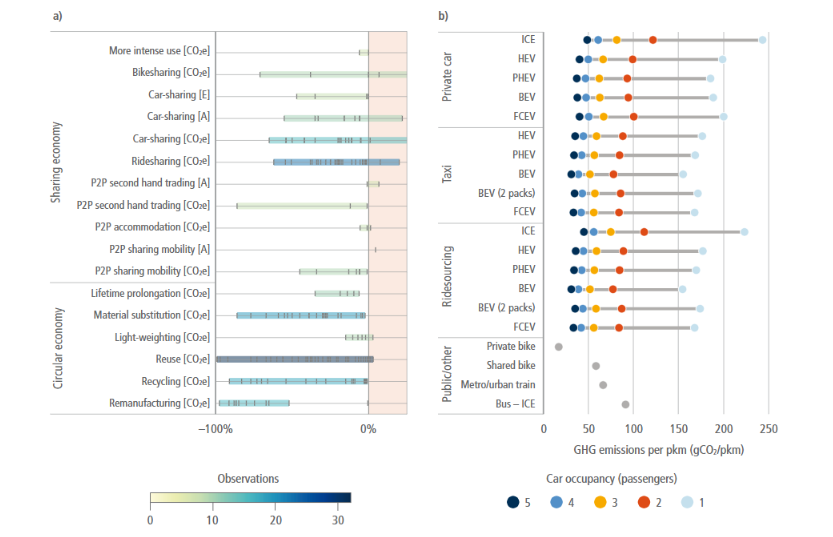Figure 5.13
Figure caption
Figure 5.13 | (a) Published estimates from 72 studies with 185 observations (indicated by vertical bars) of the relative mitigation potential of different shared and circular economy strategies, demonstrating limited observations for many emerging strategies, a wide variance in estimated benefits for most strategies, and within the sharing economy, risk of increased emissions due to inefficient substitutions, induced demand, and rebound effects. Mitigation potentials are conditional on corresponding public policy and/or regulation. (b) Attributional LCA comparisons of ridesharing mobility options, which highlight the large effects of vehicle occupancy and vehicle technology on total CO2 emissions per passenger-km and the preferability of high-occupancy and non-ICE configurations for emissions reductions compared to private cars. Also indicated are possible emissions increases associated with shared car mobility when it substitutes for non-motorised and public transit options. BEV = battery electric vehicle; FCEV = fuel cell electric vehicle; HEV = hybrid electric vehicle; ICE = internal combustion engine; PHEV = plug-in hybrid electric vehicle. Sources: data from Jacobson and King (2009); Firnkorn and Müller (2011); Baptista et al. (2014); Liu et al. (2014); Namazu and Dowlatabadi (2015); Nijland et al. (2015); IEA (2016); Koh (2016); Martin and Shaheen (2016); Rabbitt and Ghosh (2016); Bruck et al. (2017); Bullock et al. (2017); Clewlow and Mishra (2017); Fremstad (2017); ITF (2017a,b,c); Nasir et al. (2017); Nijland and van Meerkerk (2017); Rademaekers et al. (2017); Skjelvik et al. (2017); Yin et al. (2017); Campbell (2018); Favier et al. (2018); Ghisellini et al. (2018); Hopkinson et al. (2018); IEA (2018); ITF (2018); Lokhandwala and Cai (2018); Makov and Font Vivanco (2018); Malmqvist et al. (2018); Material Economics (2018); Nasr et al. (2018); Yu et al. (2018); Zhang and Mi (2018); Brambilla et al. (2019); Brütting et al. (2019); Buyle et al. (2019); Castro and Pasanen (2019); Coulombel et al. (2019); Eberhardt et al. (2019); IEA (2019b); ITF (2019); Jones and Leibowicz (2019); Ludmann (2019); Merlin (2019); Nußholz et al. (2019); Bonilla-Alicea et al. (2020); Cantzler et al. (2020); Churkina et al. (2020); Gallego-Schmid et al. (2020); Hertwich et al. (2020); ITF (2020a,b); Liang et al. (2020); Miller (2020); Wilson et al. (2020c); Yan et al. (2020); Cordella et al. (2021); Diao et al. (2021); Pauliuk et al. (2021); Ward et al. (2021); Wolfram et al. (2021).
